Bright ideas to keep you going in any situation (published Nov/Dec 2017)
Watching the drama unfold as hurricane after hurricane battered the Caribbean and Atlantic this season was horrifying. Broken boats, broken homes and broken dreams were the only thing that seemed to make the news for weeks. As sailors we may feel like we have a leg up on the general population during such a crisis, after all many of us are self-sustaining and use solar energy to power our adventures. But what happens when the systems that we rely on are damaged or destroyed? Do you have a back-up plan to keep you operational and informed?
It was the idea of a backup plan that got me researching portable and emergency solar powered devices; tools that could be used on the go, tools that take pressure off the main solar array and, most importantly, tools that would provide an invaluable service during a worse case scenario. I was looking for items that were designed to stand up to a harsh environment, were easy to use and were small enough to be included in a ditch bag. Simple solar tools that would provide invaluable essentials that anyone would struggle without; water, power and light.
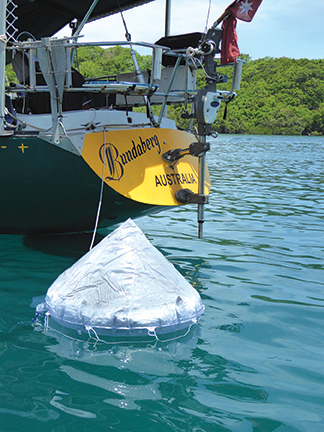 Aquamate Solar Still www.echomax.co.uk
Aquamate Solar Still www.echomax.co.uk
This basic watermaker is not designed for everyday use but would be worth it’s weight in gold in case of an emergency. Using the age-old science of evaporation as a means of purification and distillation the Aquamate Solar Still is designed to make clean drinking water using a non-potable water source such as the ocean. Simply inflate, fill with impure water, float and let the heat of the sun do the all the hard work.
Although solar water purification is not new technology—the military has been including such units in their emergency kits for over 50 years—I was a little surprised that in over a decade of yachting I hadn’t been introduced to the idea before. As part of our ditch bag on board Kate we carry a small, manual water purification filter but a passive solar water still, one that requires no strenuous activity when your energy stores are potentially depleted, sounded like a no brainer to me.
The Aquamate Solar Still will produce between 0.5 liter and 2 liters a day, depending on the water source and weather conditions. I tested it in two busy anchorages in the Philippines that I was hesitant to swim in. The item deployed in less than five minutes and I immediately saw condensation began to form on the inside of the still. During peak sun hours, I quickly collected a cup full of drinkable water. And, despite boat wake from the surrounding traffic and the occasional gust of wind in the anchorage I had no problems with the Aquamate staying right side up.
Although the solar still can be used repeatedly, once the crisis is over it does not easily go back in the box. So, like your life raft and most other emergency equipment there is no chance to familiarize yourself with how the unit works. However, with the easy to read instructions that are printed on the package in six languages there shouldn’t be a problem. The only addition I might recommend is to also include a small PVC patch kit in case the unit should get inadvertently punctured during the chaos.
Complete with an inspection number, an expiry date and endorsement by NATO this is a serious piece of kit, despite being made from PVC. Light weight, compact and trusted, adding an Aquamate Solar Still to your ditch bag could mean the difference between life and death.
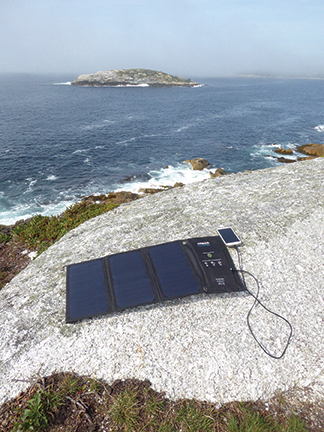 Anker 21W PowerPort Solar USB Charger www.anker.com
Anker 21W PowerPort Solar USB Charger www.anker.com
Have you ever hiked to the top of a hill to stand under the “cell phone tree” (the only place on the beautiful tropical-island-du-jour that has cellular phone service) just so you could check email or get a weather forecast? And, after finally getting a signal how many times has your battery run out before you got a chance to download that important email or the latest grib file?
With more and more boaters depending on handheld devices for communication and navigation, keeping those devices charged is a real issue. Although USB chargers might not draw a lot of immediate power, a modest 1-3 amps, over the course of the day the slow depletion of your battery banks does add up. Add to these “necessities” additional devices such as cameras, eReaders and MP3 players and suddenly it feels like your toys are drawing as much power as your fridge. So how do you keep connected and have cold beer?
A small, portable dedicated USB solar charger like the Anker 21W PowerPort Solar charger cannot only help alleviate the daily stress on your batteries, it folds up and is lightweight so it can go with you ashore on those treks to Signal Hill. Made of rugged high-wear polyester it has four hefty grommets that allow you to attach it safely to a bag or to the boat to keep it where you need it while in use. The solar panels are faced with industrial strength PET and the two USB ports are enclosed in a pocket so you can keep a small device under cover while charging, which is handy underway when items may get splashed.
I tested the Anker PowerPort onboard, while ashore on day trips and while traveling and really found it handy. It has a possible charging speed of 2.4 amps per port or 3 amps overall, dependant on the intensity of sunlight. It not only kept up in the cockpit but I never found myself with a flat battery while we were out having fun or, more importantly, chasing Wi-Fi.
However, I did have trouble keeping my device cool while charging; I often found it difficult to keep the Anker PowerPort in the direct sun and my device tucked away in the shade with a standard-length USB cord.
A little bigger than a typical tablet when folded the Anker PowerPort is a handy gadget to have on hand for everyday use and during a crisis it will keep you powered up so you can stay connected, no matter where you are.
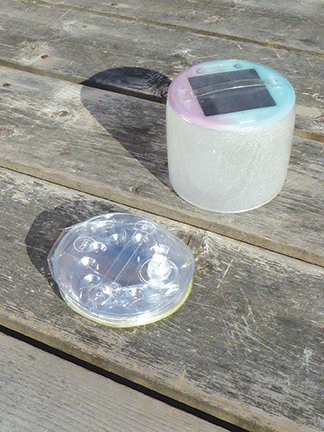 LUCI Lights www.mpowerd.com
LUCI Lights www.mpowerd.com
If you’ve done any coastal cruising after dark recently you’ve seen the difference solar powered lights have made. Across the globe most navigational aids now rely on small solar panels and rechargeable batteries to keep the lights illuminated at night. Look around a typical anchorage and no doubt several boats will have an array of dim solar powered garden lights in lieu of a mast top anchor light. So, when I discovered the solar powered, portable LUCI lights I thought they looked like a great idea.
Deflating to less than an inch LUCI lights are compact, lightweight and easy to store when not in use. When inflated these lights are not just practical they are stylish. Available in both white and colored lamps, LUCI lights are designed for outdoor use. The Outdoor 2.0 light is even rated as waterproof, in case you forget it in the cockpit on a rainy night. The white light has three brightness settings; bright enough to work by and dim enough to use as ambient lighting. But it is the colored lamp that I use most. Underway I used the red setting to preserve my night vision, we liked the blue setting for a soft, ambient light in the cabin at night on anchor and if you were looking for a fun night light for the junior crew members this would be my pick.
The LUCI lights do require very direct sun to charge properly and fully charged are rated for 12 hours of illumination. However, I did notice that the colored lights did not stay lit as long as the white lamps, I expect the number of LED’s used to produce the various colors draw more power.
I was concerned that the PVC would deteriorate during the long hot hours of charging in the direct sun of the hot tropics, but after months of daily exposure they look and feel like new. One thing that was disappointing was how easy the lights can be punctured when transporting them inflated. Like any inflatable toy, be mindful of sharp edges.
It wasn’t until we started sailing in remote areas of the Solomon Islands that I really appreciated how much artificial lighting effects people’s everyday activities. Without lights, many of the communities we anchored next to simply stopped at sunset. From work to travel, it’s hard to do much after dark without a light. Mpowerd, the inventors of the LUCI light, realise this struggle too. Collaborating with non-profit organizations around the world they work to bring light to children and communities that need them. Mpowerd has already “provide(d) clean, safe solar lights” to people in over 90 developing countries. Now that’s a bright idea.
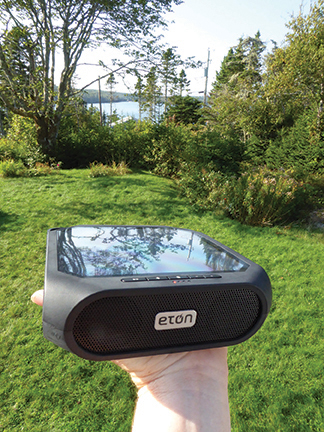 Rugged Rukus Solar Speaker www.etoncorp.com
Rugged Rukus Solar Speaker www.etoncorp.com
At first glance something like a portable, solar powered speaker might seem like a frivolous item. After all, life isn’t exactly hard when you’re BBQ-ing on the beach. But what if you could use it to listen to emergency information broadcast during a crisis?
We’ve been through three tsunami warnings and sailed into two different countries directly after a major cyclone stormed through. During those times, the best way to get information was via local radio broadcasts. Paired with a device like a phone or MP3 player that has an FM tuner the Rugged Rukus becomes a portable radio, keeping you and everyone within earshot up to date.
The Rukus is slightly larger than a good-sized paperback but packs a punch when it comes to sound. Bluetooth compatible it can also connect to devices via a headphone jack, so even your older MP3 player can be used. It can be quick charged using a USB cord but a full charge using the sun will only take about 5 hours, depending on how clear the skies are. I especially like the two loops built into the case, a perfect spot to attach a lanyard to prevent it from accidently going in the drink.
With an IPX4 rating the Rugged Rukus is drop-proof and spill-proof. Although I haven’t exactly been gentle with this gadget during testing, I do have a tough time being intentionally careless with gear. However, I spoke to a user with three active, preteen boys and she reports that not only has the unit been dropped a few times but it was also left outside in a heavy rain one night. Yet, even after repeated accidents and abuse their Rugged Rukus is still rocking two years later.
On board, at the beach, everyday or in case of emergency, this solar powered portable speaker is compact enough to be taken anywhere. Perhaps the best feature of the Rukus is the USB OUT port, allowing you to charge any USB compatible device. So, not only do you get a portable sound system you also get a portable USB solar charger. And, as every cruiser knows, an item that can do double duty is always welcome onboard.
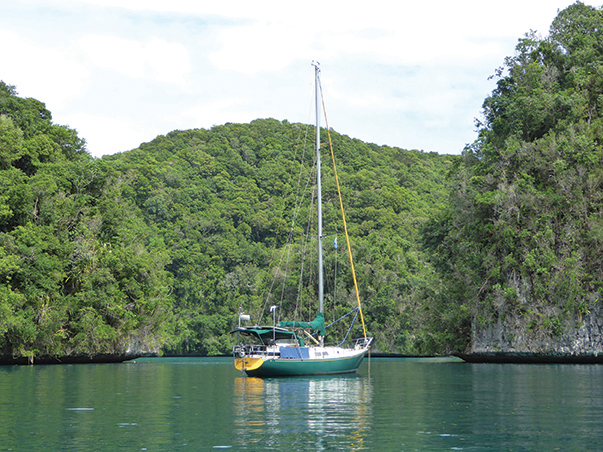 Harnessing the power of the sun is nothing new for boaters, but keeping up with power demands is never easy, especially with the increasing number of devices in use daily. No matter what kind of solar systems you have in place keeping a few extra tools onboard can help take the load off, and will certainly come in handy when disaster strikes.
Harnessing the power of the sun is nothing new for boaters, but keeping up with power demands is never easy, especially with the increasing number of devices in use daily. No matter what kind of solar systems you have in place keeping a few extra tools onboard can help take the load off, and will certainly come in handy when disaster strikes.
*All items were sent to Blue Water Sailing for testing, however all opinions are those of the author.
Heather Francis is originally from Nova Scotia, Canada. In 2008 she and her Aussie partner Steve bought Kate, a Newport 41’, in southern California and have been sailing her full-time since. They are currently in the Philippines and are planning to do a lap around the planet, albeit slowly. To follow their adventure, log on to www.yachtkate.com.















